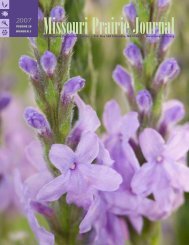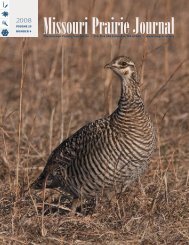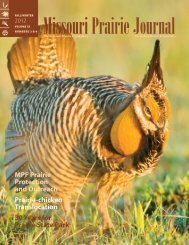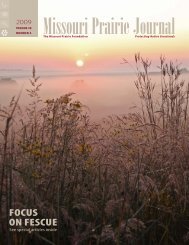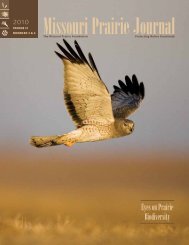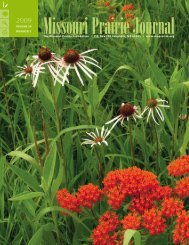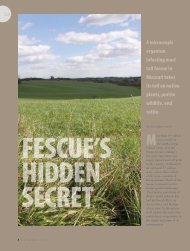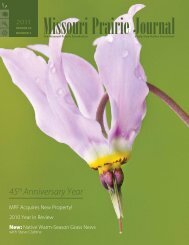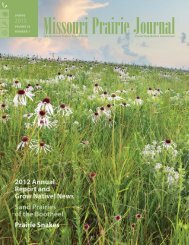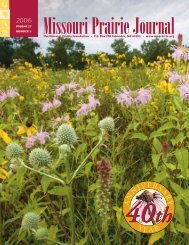Fall 2007: Volume 28, Number 4 - Missouri Prairie Foundation
Fall 2007: Volume 28, Number 4 - Missouri Prairie Foundation
Fall 2007: Volume 28, Number 4 - Missouri Prairie Foundation
You also want an ePaper? Increase the reach of your titles
YUMPU automatically turns print PDFs into web optimized ePapers that Google loves.
Pure <strong>Prairie</strong><strong>Prairie</strong> Professionals<strong>Prairie</strong> Wildlife BiologistSteve ClubineFrank Oberle<strong>Missouri</strong> Department ofConservation biologistand <strong>Missouri</strong> <strong>Prairie</strong><strong>Foundation</strong> advisor Steve Clubinehas spent more than 35 yearsstudying grassland communitiesand uses his knowledge to conserve,protect and re-establish <strong>Missouri</strong>prairies.Steve is the “go to guy” forinformation on native grasses,invasive species, grassland fauna,grazing and prescribed burning. Heunderstands species interactions,nutrient cycles and disturbancepatterns within grassland communities,and has trained hundreds oflandowners and other prairie professionals.The author and/or citationsource for numerous articles,papers and books on grasslandrestoration, prescribed burning,grazing and grassland wildlife management,Steve regularly speaks atconservation conferences throughoutthe Midwest.Steve supervised Sharron Gough, now a private lands conservationistwith the Conservation Department, for the first 10 years ofher career in prairie-chicken conservation. Sharron said “Steve was abottomless resource for me for all things pertaining to grassland andgrass management. He has developed an enormous network of peersin the field and keeps up on research and current issues impactinggrasslands both in <strong>Missouri</strong> and throughout the plains states. He’s akeen observer of grassland systems and has expedited the evolutionof management systems that sustain both wildlife and livestock morethan anyone I know in <strong>Missouri</strong>. And he can talk non-stop for daysabout grassland management and never repeat himself—I know, I’vewitnessed it many times!”Steve says that a course in Range Management at Kansas StateUniversity “pulled it all together” for him, and set him on his careerpath. “My dad had cattle on Kansas’ native prairies,” said Steve.“When I began to understand how the various elements— grazing,fire, variety of plant and animal species—worked together to form afunctioning grassland community, the light bulb went on and I knewwhat I wanted to do with my life.”Thirty years ago, when Steve came to the ConservationDepartment, he actually had to show <strong>Missouri</strong>ans that native grassescould be planted and grown in the state. He followed that by demonstratingthe advantages of controlled burning and managed grazingand haying patterns. By the 1990s, understanding of native grassestablishment and appreciation for native grasses was well establishedwithin the state, allowing Steve to focus on making grasslands functionalfor native plants and wildlife and working with <strong>Missouri</strong>’s publicand private land managers.“But by then, greater prairie-chicken populations haddiminished,” said Steve. Today, Steve is on a quest to enable prairiechickensto rebound. He is eager to begin a re-introduction programslated for March 2008, which will use prairie-chickens imported fromKansas.Steve says the reintroduction will be a huge effort, requiringdozens of people and intensive management, but he is motivated bythe hope that the sound of booming birds will be heard in the springfor generations to come.Lee Phillion, MPF board memberMax Alleger38





